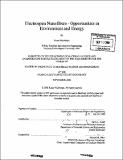| dc.contributor.advisor | Harry L. Tuller. | en_US |
| dc.contributor.author | Mukherjee, Kunal, Ph. D. Massachusetts Institute of Technology. | en_US |
| dc.contributor.other | Massachusetts Institute of Technology. Dept. of Materials Science and Engineering. | en_US |
| dc.date.accessioned | 2009-04-29T17:35:00Z | |
| dc.date.available | 2009-04-29T17:35:00Z | |
| dc.date.copyright | 2008 | en_US |
| dc.date.issued | 2008 | en_US |
| dc.identifier.uri | http://hdl.handle.net/1721.1/45392 | |
| dc.description | Thesis (M. Eng.)--Massachusetts Institute of Technology, Dept. of Materials Science and Engineering, 2008. | en_US |
| dc.description | Includes bibliographical references (leaves 53-56). | en_US |
| dc.description.abstract | One-dimensional nanostructures have several attractive material properties compared to their bulk counterparts and have found applications in many novel devices. They have especially shown promise in the fields of renewable energy generation and environmental monitoring by improving solar cells and gas sensors. However difficulties in large scale manufacturing of these nanostructures have prevented most of these devices from entering the marketplace. Electrospinning is a simple, versatile and scalable technique to fabricate one-dimensional nanostructures in the form of nanofibers. It has recently been successfully used to produce semiconducting metal oxide nanofibers which have been used in chemiresistive gas sensors and dye-sensitized solar cells. Electrospun gas sensors and solar cells have already been shown to perform better than many of its competitors in a very short period of time. This coupled with low manufacturing costs and well protected intellectual property makes electrospinning a good candidate to bring the advantages of one-dimensional nanostructures into the marketplace. | en_US |
| dc.description.statementofresponsibility | by Kunal Mukherjee. | en_US |
| dc.format.extent | 60 leaves | en_US |
| dc.language.iso | eng | en_US |
| dc.publisher | Massachusetts Institute of Technology | en_US |
| dc.rights | M.I.T. theses are protected by
copyright. They may be viewed from this source for any purpose, but
reproduction or distribution in any format is prohibited without written
permission. See provided URL for inquiries about permission. | en_US |
| dc.rights.uri | http://dspace.mit.edu/handle/1721.1/7582 | en_US |
| dc.subject | Materials Science and Engineering. | en_US |
| dc.title | Electrospun nanofibers : opportunities in environment and energy | en_US |
| dc.type | Thesis | en_US |
| dc.description.degree | M.Eng. | en_US |
| dc.contributor.department | Massachusetts Institute of Technology. Department of Materials Science and Engineering | |
| dc.identifier.oclc | 317403642 | en_US |
